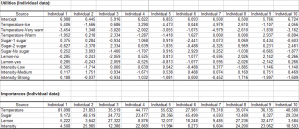Análisis conjunto
Full profile conjoint analysis is used in marketing to detect desirable product attributes from ratings or rankings. Do it in Excel with the XLSTAT software.

What is conjoint analysis?
Conjoint analysis is a comprehensive method for the analysis of new products in a competitive environment.
This tool allows you to carry out the step of analyzing the results obtained after the collection of responses from a sample of people. It is the fourth step of the analysis, once the attributes have been defined, the design has been generated and the individual responses have been collected.
Full profile conjoint analysis is based on ratings or rankings of profiles representing products with different characteristics. These products have been generated using a design of experiments and can be real or virtual. The analysis is done using two statistical methods:
- Analysis of variance based on ordinary least squares (OLS).
- Monotone analysis of variance (Kruskal, 1964) that uses monotonic transformations of the responses to better adjust the analysis of variance (MONANOVA).
Results of conjoint analysis
Conjoint analysis therefore provides for each individual what is called partial utilities associated with each category of the variables. These utilities provide a rough idea of the impact of each modality on the process of choosing a product.
In addition to utilities, conjoint analysis provides an importance associated with each variable.
It shows how each variable in the selection process associated with each individual is important.
The full profile conjoint analysis details the results for each individual separately, which preserves the heterogeneity of the results.
XLSTAT Marketing analysis software also proposes to make classifications on the individuals. Using the utilities, XLSTAT-Conjoint will obtain classes of individuals that can be analyzed and be useful for further research. Classification methods used in XLSTAT-Conjoint are the agglomerative hierarchical classification and the k-means method.
Type of data for conjoint analysis
XLSTAT-Conjoint offers two types of input data for the conjoint analysis: rankings and ratings. With rankings, the best profile will have the lowest value, whereas with a rating, it will have the highest value.


analice sus datos con xlstat
Incluido en